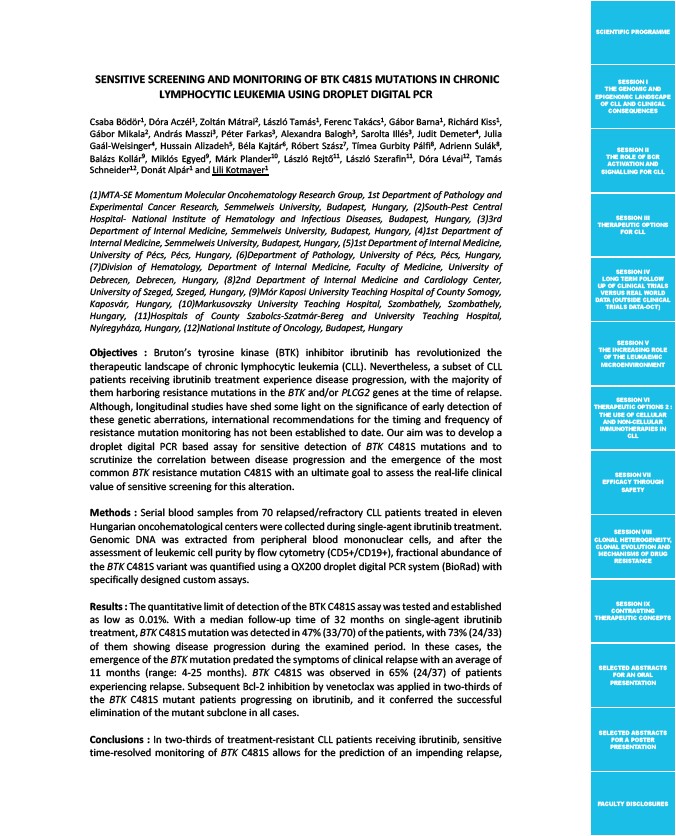
SCIENTIFIC PROGRAMME
SESSION I
THE GENOMIC AND
EPIGENOMIC LANDSCAPE
OF CLL AND CLINICAL
CONSEQUENCES
SESSION II
THE ROLE OF BCR
ACTIVATION AND
SIGNALLING FOR CLL
SESSION III
THERAPEUTIC OPTIONS
FOR CLL
SESSION IV
LONG TERM FOLLOW
UP OF CLINICAL TRIALS
VERSUS REAL WORLD
DATA (OUTSIDE CLINICAL
TRIALS DATA-OCT)
SESSION V
THE INCREASING ROLE
OF THE LEUKAEMIC
MICROENVIRONMENT
SESSION VI
THERAPEUTIC OPTIONS 2 :
THE USE OF CELLULAR
AND NON-CELLULAR
IMMUNOTHERAPIES IN
CLL
SESSION VII
EFFICACY THROUGH
SAFETY
SESSION VIII
CLONAL HETEROGENEITY,
CLONAL EVOLUTION AND
MECHANISMS OF DRUG
RESISTANCE
SESSION IX
CONTRASTING
THERAPEUTIC CONCEPTS
SELECTED ABSTRACTS
FOR AN ORAL
PRESENTATION
SELECTED ABSTRACTS
FOR A POSTER
PRESENTATION
FACULTY DISCLOSURES
SENSITIVE SCREENING AND MONITORING OF BTK C481S MUTATIONS IN CHRONIC
LYMPHOCYTIC LEUKEMIA USING DROPLET DIGITAL PCR
Csaba Bödör1, Dóra Aczél1, Zoltán Mátrai2, László Tamás1, Ferenc Takács1, Gábor Barna1, Richárd Kiss1,
Gábor Mikala2, András Masszi3, Péter Farkas3, Alexandra Balogh3, Sarolta Illés3, Judit Demeter4, Julia
Gaál-Weisinger4, Hussain Alizadeh5, Béla Kajtár6, Róbert Szász7, Tímea Gurbity Pálfi8, Adrienn Sulák8,
Balázs Kollár9, Miklós Egyed9, Márk Plander10, László Rejtő11, László Szerafin11, Dóra Lévai12, Tamás
Schneider12, Donát Alpár1 and Lili Kotmayer1
(1)MTA-SE Momentum Molecular Oncohematology Research Group, 1st Department of Pathology and
Experimental Cancer Research, Semmelweis University, Budapest, Hungary, (2)South-Pest Central
Hospital- National Institute of Hematology and Infectious Diseases, Budapest, Hungary, (3)3rd
Department of Internal Medicine, Semmelweis University, Budapest, Hungary, (4)1st Department of
Internal Medicine, Semmelweis University, Budapest, Hungary, (5)1st Department of Internal Medicine,
University of Pécs, Pécs, Hungary, (6)Department of Pathology, University of Pécs, Pécs, Hungary,
(7)Division of Hematology, Department of Internal Medicine, Faculty of Medicine, University of
Debrecen, Debrecen, Hungary, (8)2nd Department of Internal Medicine and Cardiology Center,
University of Szeged, Szeged, Hungary, (9)Mór Kaposi University Teaching Hospital of County Somogy,
Kaposvár, Hungary, (10)Markusovszky University Teaching Hospital, Szombathely, Szombathely,
Hungary, (11)Hospitals of County Szabolcs-Szatmár-Bereg and University Teaching Hospital,
Nyíregyháza, Hungary, (12)National Institute of Oncology, Budapest, Hungary
Objectives : Bruton’s tyrosine kinase (BTK) inhibitor ibrutinib has revolutionized the
therapeutic landscape of chronic lymphocytic leukemia (CLL). Nevertheless, a subset of CLL
patients receiving ibrutinib treatment experience disease progression, with the majority of
them harboring resistance mutations in the BTK and/or PLCG2 genes at the time of relapse.
Although, longitudinal studies have shed some light on the significance of early detection of
these genetic aberrations, international recommendations for the timing and frequency of
resistance mutation monitoring has not been established to date. Our aim was to develop a
droplet digital PCR based assay for sensitive detection of BTK C481S mutations and to
scrutinize the correlation between disease progression and the emergence of the most
common BTK resistance mutation C481S with an ultimate goal to assess the real-life clinical
value of sensitive screening for this alteration.
Methods : Serial blood samples from 70 relapsed/refractory CLL patients treated in eleven
Hungarian oncohematological centers were collected during single-agent ibrutinib treatment.
Genomic DNA was extracted from peripheral blood mononuclear cells, and after the
assessment of leukemic cell purity by flow cytometry (CD5+/CD19+), fractional abundance of
the BTK C481S variant was quantified using a QX200 droplet digital PCR system (BioRad) with
specifically designed custom assays.
Results : The quantitative limit of detection of the BTK C481S assay was tested and established
as low as 0.01%. With a median follow-up time of 32 months on single-agent ibrutinib
treatment, BTK C481S mutation was detected in 47% (33/70) of the patients, with 73% (24/33)
of them showing disease progression during the examined period. In these cases, the
emergence of the BTK mutation predated the symptoms of clinical relapse with an average of
11 months (range: 4-25 months). BTK C481S was observed in 65% (24/37) of patients
experiencing relapse. Subsequent Bcl-2 inhibition by venetoclax was applied in two-thirds of
the BTK C481S mutant patients progressing on ibrutinib, and it conferred the successful
elimination of the mutant subclone in all cases.
Conclusions : In two-thirds of treatment-resistant CLL patients receiving ibrutinib, sensitive
time-resolved monitoring of BTK C481S allows for the prediction of an impending relapse,